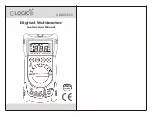
General Maintenance
Introduction
2
Introduction
This chapter provides handling, cleaning, fuse replacement, and display test instructions
for the Meter.
General Maintenance Information
The following sections describe how to maintain the Meter.
Required Equipment
Equipment required for calibration, troubleshooting, and repair of the Meter is listed in
Table 3-1.
Static Safe Handling
All integrated circuits, including surface mounted ICs, are susceptible to damage from
electrostatic discharge (ESD). Modern integrated circuit assemblies are more susceptible
to damage from ESD than ever before.
Integrated circuits today can be built with circuit lines less than one micron thick,
allowing more than a million transistors on a 1/4-inch square chip. These submicron
structures are sensitive to static voltages under 100 volts. This much voltage can be
generated on a dry day by simply moving your arm. A person can develop a charge of
2,000 volts by walking across a vinyl tile floor, and polyester clothing can easily generate
5,000 to 15,000 volts during movement against the wearer. These low voltage static
problems are often undetected, because a static charge must be in the 30,000 to 40,000
volt range before a person will feel a shock.
Most electronic components manufactured today can be degraded or destroyed by ESD.
While protection networks are used in CMOS devices, they can only reduce, not
eliminate, component susceptibility to ESD.
ESD may not cause an immediate failure in a component; a delayed failure or
"wounding" effect is caused when the semiconductor’s insulation layers or junctions are
punctured. The static problem is thus complicated in that failure may occur anywhere
from two hours to six months after the initial damage.
Two failure modes are associated with ESD. First, a person who has acquired a static
charge can touch a component or assembly and cause a transient discharge to pass
through the device. The resulting current ruptures the junctions of a semiconductor. The
second failure mode does not require contact with another object. Simply exposing a
device to the electric field surrounding a charged object can destroy or degrade a
component. MOS devices can fail when exposed to static fields as low as 30 volts.
Observe the following rules for handling static-sensitive devices:
1. Handle all static-sensitive components in a static-safe work area.
Use grounded static-control table mats on all repair benches, and always wear a
grounded wrist strap. Handle boards by their nonconductive edges only. Store plastic,
vinyl, and Styrofoam objects outside the work area.
2. Store and transport all static-sensitive components and assemblies in static shielding
bags or containers.
Static-shielding bags and containers protect components and assemblies from direct static
discharge and external static fields. Store components in their original packages until they
are ready for use.
2-3
Summary of Contents for DMM4020
Page 1: ...DMM4020 Digital Multimeter Technical Reference Revision B 077 0365 02...
Page 6: ...DMM4020 Technical Reference iv...
Page 8: ...DMM4020 Technical Reference vi...
Page 10: ...DMM4020 Technical Reference 1 2...
Page 24: ...DMM4020 Technical Reference 1 16...
Page 26: ...DMM4020 Technical Reference 2 2...
















































